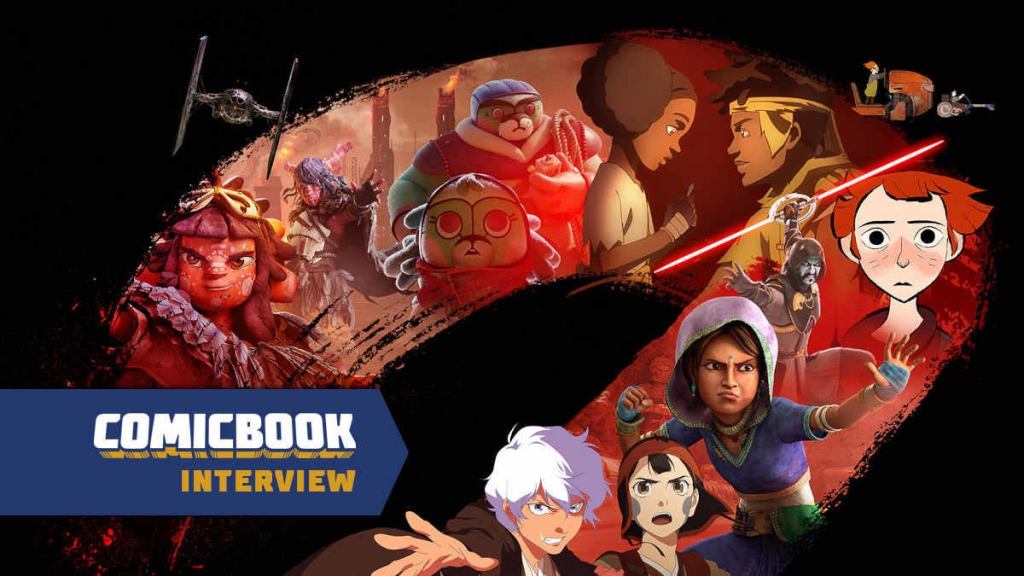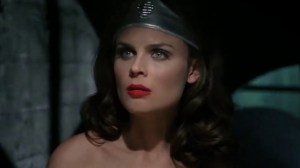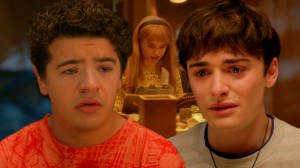Star Wars: Visions , and this Star Wars Day, its producers are hoping to do it again, on a more international scale. The first volume of Star Wars: Visions features animated Star Wars shorts from some of the top animation studios in Japan, fusing Star Wars mythology with anime style. But as producer James Waugh explained to us during our interview ahead of the new season’s release, those animators also brought their cultural history and point-of-view to their shorts. He and fellow producers Jacqui Lopez and Josh Rimes decided to seek out additional cultural perspectives for the second volume of , tapping some of the most exciting animation studios from different countries across the globe to put their distinct spins on the Star Wars universe.
Videos by ComicBook.com
ComicBook.com spoke to all three producers about Star Wars: Visions Volume 2. Here’s what they had to tell us:

Was it always the plan for Star Wars: Visions to be multiple volumes? Or is this second season and its expansion to have a global reach the result of reactions you got from fans and critics and everyone who saw the first season?
James Waugh: I think we always believed that the potential of Star Wars Visions could be an incredible canvas for new types of storytelling across media, and we even saw a little of that with the publishing component of volume one. I think we really saw it as a place that could just be a place for celebratory Star Wars storytelling that was really from the best writers around in their craft but wasn’t really trying to fit on that long-term economical timeline.
So we always believed in the potential of it, but it was an experiment. It was really from a place of love, of loving anime, of loving the animation community and wanting to showcase it and wanting to see what Star Wars could look like and feel like expressed through those voices. So when it actually started getting the traction that it got and the fandom and love, we were of course incredibly delighted and over the moon, but it gave us license for it. In a way, it sort of validated this idea that Star Wars could, within this framework, expand and explore different things.
And so ultimately with Volume 2, one of the things we noticed with Volume 1 was that not only was it amazing because it was really just good anime storytelling, anime spectacle, and anime Star Wars, but there were choices that were made throughout that could only come from creators that were from Japan, that had specific Japanese reference points historically, culturally, religiously, and just cinematic style, and that stayed with us. It lingered, and we suddenly started wondering what that could look like through all different other cultural lenses. What else could we see found through different countries, through different cultures?
And we’re such big animation fans that there were so many studios globally, so many new styles, so many unique methodologies that are happening now that we thought that this would be a great opportunity to switch it up and showcase all of that and go on that kind of global tour. We love anime and I think we definitely want to go back to anime at some point with Star Wars, but we felt there was so much more, so many other cultural perspectives that we showcased through this platform.
Part of what makes this series unique is that it is not part of the wider expanding Star Wars universe, which is pretty much all of Star Wars at this point. Was the fact that it is outside of continuity seen as a challenge or a potentially hard sell with audiences? Or was it seen as a strength, something that would allow you to do things that maybe you couldn’t do otherwise?
JW: I think all of that, right? I think it was an experiment. I think one of the great powers of Star Wars is it’s this franchise that all these things connect in so many powerful ways and you can enter it from all different places, and there is this timeline that is this ongoing history, but what you couldn’t get with that are unexpected choices like “The Duel,” things that were stylistically really a celebration about the medium and the influences of Star Wars, the influences of Akira Kurosawa and George Lucas, and that was really a celebration of the medium and cinema in general, or “T0-B1” is a love letter, really, to early manga and Astro Boy. So yeah, I think it was an experiment, but it was also part of the power of it as well, that you can really lean into the form.
You also mentioned the publishing aspects. We got a couple of spinoffs from Volume 1, mostly focusing on “The Ronin.” Do you foresee future projects like that? Is there any particular episode in this volume that you think could lend itself to expansion the way “The Ronin” did?
JW: Well, there’s nothing immediately coming out at the moment, but all of these stories are super expandable. All of these stories have the potential of traversing platform, traversing medium. There are probably other stories to tell what each one of these characters, and I think we all believe that Visions is a framework that instantly tells the audience what the expectations are for this and to kind of lean into it from a celebratory perspective and just take in the good storytelling without the other contingencies is something that I think easily could happen again with this initiative. There’s nothing really coming out at the moment, but I don’t know, I kind of want to see so many of these stories continue.
I didn’t mean to single out James! Jacqui and Josh, is there anything either of you wanted to add to what he said?
Josh Rimes: I would just say at the end of the day, these stories are such a celebration of the cultures of these studios. And James touched on it, but I think you see it from the stories made by 88 Pictures in India to a banshee story in Ireland. I think that’s what really drew us to these creators and they just jumped at it immediately. They kind of understood, and I think that just shows the power of Star Wars, right? That it transcends, and these stories are so mythic, and you could tell, again, mythic stories with different cultures through the lens of Star Wars very easily, and in different styles too.
Jacqui Lopez: The styles is one thing I would say, is just being able to see the galaxy in Aardman, in stop-motion. As soon as their designs started coming in, we would just freak out every week, just like, “Oh my God, this is amazing.” And being able to visit there and see the puppets, and then seeing the Cartoon Saloon style. That’s the other thing, is just celebrating this world in so many different visual mediums was really fulfilling too, and what Visions allows us to do.
Star Wars: Visions Volume 2 debuts on Disney+ on May 4th.








